Most of my trips to Yukon have been to the southern part of the province (Whitehorse and Dawson). Note that the name is Yukon, not the english version “The Yukon” - its like the plural of Canada Goose is Canada Goose. Canada is bilingual and official terminology has to be “neutral” as to English or French indicators. Note also, that many maps still refer to the area as Yukon Territory, that changed to Yukon in 2002.
The video presented below depicts a road trip up The Dempster Highway which runs north through Yukon to Fort McPherson and Inuvik in the Northwest Territories in July of 2000. From Inuvik we took a short flight to Tuktoyaktuk (Tuk to almost everyone) on the coast of the Beaufort Sea (Arctic Ocean). The video portfolio, The Birds of the United States and Canada, contains material from this trip.
The Yukon & Northwest Territories photo gallery contains photos from the Dempster trip and other outings.
***
In the first part of this century we loaded three people (Rebecca, Jon, and myself), camping equipment for three weeks, extra wheels and tires, and camera equipment into a Honda Civic and drove thousands of miles to Inuvik, Northwest Territories, Canada. Of course, once there we had to keep going, even though the Dempster ended at Inuvik at that time (or at Dawson City, Yukon -- depending on perspective). We caught a plane and flew to Tuktoyaktuk on the Arctic Ocean.
“The Dempster” (below or at the link) records the birds and adventures of this trip. The Dempster Highway runs between Dawson City (Yukon) and Inuvik (Northwest Territory), Canada - 417 miles of gravel through majestic and mosquito infested scenery. It crosses; several streams and rivers (including the Peel and Mackenzie), the Continental Divide between the Pacific [Bering Sea] and Arctic [Beaufort Sea] Oceans, and the Arctic Circle in the process. This video includes footage of Black and Grizzly Bears, Dall Sheep, Sparrows, Ducks, Eagles, Ptarmigan, Loons, Jaegers...
MOSQUITOES
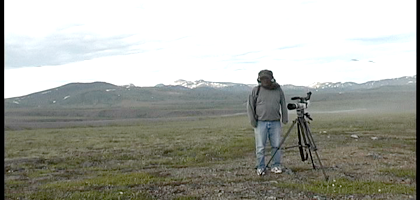
Twice I have been driven crazy by mosquitoes. I don’t mean the obnoxious buzzing, slapping, swelling bother of mosquitoes at Malheur NWR in July and August. I mean the slap your face and kill 132 mosquitoes type of crazy. The crazy where all you hear is the buzzing and your body cringes with the thought of the hoards - once in the Everglades and once in Yukon.
It is the summer solstice and I have just stood on the Arctic Circle. Now I’m out on the tundra shooting an introduction for what will be “The Dempster, Legendary Road of the North”. Boots, rain pants over jeans, coat, hat, gloves, mosquito netting, and five million mosquitoes -- proof that adventures are better after they happen. Gloves are off to adjust the wireless microphone but keep the mosquitoes away from the face, they are all over my hands. Plover, try for the Plover, great shot of the Plover, mosquitoes, can’t stand it any more run for the car. Later, eating, or trying to. Lift the netting, take a bite, pull the netting back down. This is not fun. This is crazy.
STREAM CROSSINGS
Even in the Arctic there were times when the mosquitoes are manageable, when the wind is blowing for instance. Arctic streams often have a base of rock and sand, are swiftly flowing, and are cold. Typically each step of a stream ford is tenuous with rocks rolling down the stream or the bottom constantly dissolving beneath your feet, with each step you disturb the bottom and the current carries everything away. Often the streams are brown or a chalky gray (when they originate from glaciers) and you can’t see the bottom. And the cold is the kind that hurts, deep throbbing pain. The cold brings numbness, so bad that after a crossing you find bruises from rolling rocks you barely felt.
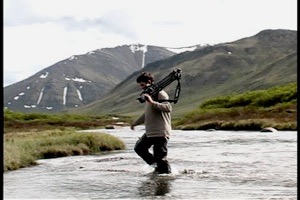
Grizzly Bears hardly slow down as they crash through these streams. So much beauty and fluidity as they race across the flats like a mammalian locomotive.
Later in the day mentioned above we trudged across the tundra, soft mushy tundra, fording the occasional stream. It might be interesting to tape a stream crossing for "The Dempster" I think. Time to call on my son, a willing and able Sherpa:
“Carry this tripod across the stream” (several times to get the shot right).
“Once is enough, you are trying to drown me!”
“Nah, its not that bad.”
“Yes it is, it’s really fast!”
“Okay, just walk out halfway, stop before the deep part and walk back.”
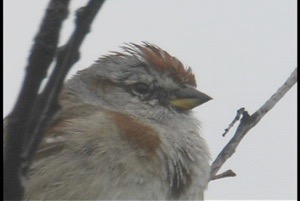
“What is it with this younger generation of Sherpas” I mutter to myself as the tripod I am using slips downstream again and my feet sink into the stream bed.
...north of the Article Circle along the Dempster Highway in Canada, where the shore birds constantly call from their perches on the tops of bushes and small trees, there are no other birders about. (Greater Yellowlegs in the Yukon to the right.) Equally, evocative is the idea that birding at 2 a.m. is not only feasible, but quite enjoyable in fact. It is very light and the birds are active, even the American Tree Sparrow shown in the photograph to the right.
A FLIGHT TO TUK
The last part of this trip (or the middle part if you count the coming back) was a trip to Tuk. These were my thoughts at the time: It is July (2000) and Rebecca, Jon, and I are flying in a small plane from Inuvik in the Northwestern Territories of Canada to Tuktoyaktuk on the Beaufort Sea (Arctic Ocean). The weather is clear and you can see for miles.
The pilot and I talk about navigation and flying. Navigation here is by dead reckoning and by GPS - a compass and traditional methods are useless this close to magnetic north.
As for flying, “This time of year we fly whenever it is light” he said.
“It’s light all the time, this time of year”, I responded.
“Yeah”, he smiled (luckily it didn’t look like a sleepy smile.)
Here and there, ice hummocks called pingos (photo from plane at right) rise from the tundra. These hills are actually ice mountains created by permafrost heaving, their cores are solid ice, their covering is tundra. All through this region these hills are used as natural refrigerators. We are hoping to see Beluga or Polar Bear from the air, not much luck. The pack ice is still preventing the whales from coming in close to shore. No birds either, just flat scenery traveling off in all directions to the horizon.
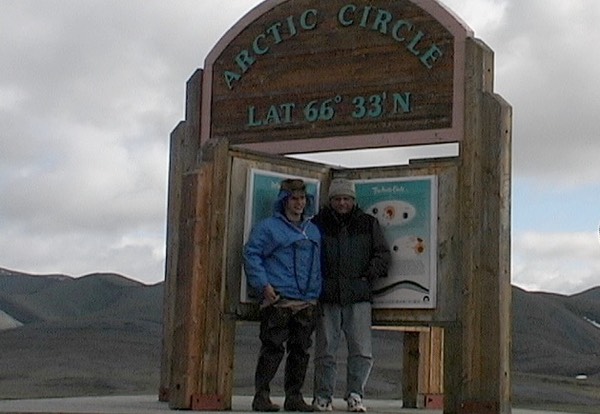
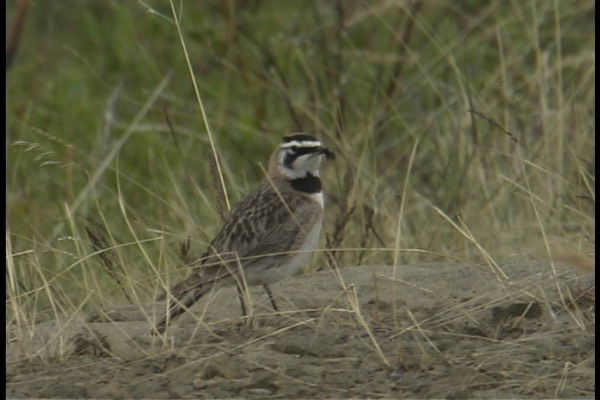
THE ARCTIC CIRCLE
The Arctic Circle, one of those magical, mysterious, adventurous sounding names. The far north, the hardship… The Arctic Circle, a human construct, it is marked on the map, it is marked along the road. You feel no different a mile north of it than you did a mile south of it.
It was a cold day when Jon and I stood at the Arctic Circle.
HORNED LARKS
In our walks about the countryside we often encountered Horned Larks. As a general rule, small birds tend to hop about on the ground. The Horned Lark, which walks, is one exception to the general rule.
It is the exception to the rule which often make life interesting. There are always multiple futures, multiple scenarios - and some of them “just didn’t happen to attain the privilege of empirical realization” (Steven Jay Gould in the essay “Seventh Inning Stretch”). If the Horned Lark had evolved to hop instead of to walk what would have been the implications from the world? I don’t know, my gut tells me not much, chaos theory indicates that the difference could be significant. It is the branching possibilities of the tree of the future which is intriguing. As our science becomes more mature and our understanding of the laws of gravity, evolution, thermodynamics, etc. become more comprehensive the roots and trunk of the tree become better defined. Given the myriad relationships of any object or action it is difficult for me to ascertain how we can ever develop a cognitive model of the futures.